Radford Racing School High Performance Driving Program: Day 2 & Beyond
While there was some brief classroom time on my second day at Radford Racing School, the second day of the program brought about much more seat time than in day 1.
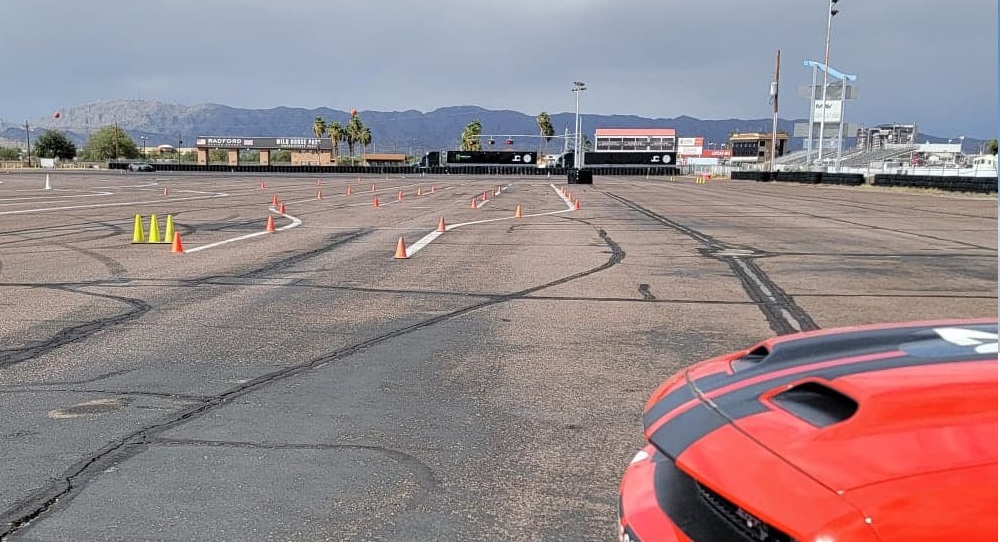
Our first exercise focused on braking and how to read the systems of cones around the track which make up the braking zones. Every turn on the Radford tracks is preceded by a series of cones, most of which have three cones, then two, then one. Out on the tarmac, that same system of cones was joined by a pair of cones that serve as the goal for the exercise. On the instructor’s mark, we would accelerate from a stop to 65 mph, braking at the three-cone set in a manner that allowed us to smoothly stop between the goal cones. The ultimate goal here is to stop at the goal cones in one smooth motion, applying just enough braking pressure to stop where we want, but without having to add or remove brake pressure. We practiced three times by stopping from the three-cones mark, then three times from the two-cone mark and one-cone mark, with the one-cone mark being a very hard, quick stop. All along, our goal as students was to apply the brake starting at the specified cone mark and stop at the goal cones in one smooth motion. At first, I was stopping a bit too early, as I was applying too much brake pressure too soon, but I got a hang of it after a handful of tries.
Next, we moved onto braking into a box of cones, which was the most difficult exercise for me during the Radford HPD course. We accelerated hard to 65 and when we reached a 100-foot-long box of cones, we had to brake hard and swerve out the open side-end of the box. Ideally, we would hit the brakes, swerve out of the box of cones and straighten the car to end up pointed in the same direction in which we started. Brake and steer too slowly and you plowed through the cones at the end of the box. Steer too gently on your turn out of the box and you knocked out the cone at the end of the box, which was my issue on a few runs. Other students swerved too soon and took out cones on the side of the box, but over time, everyone in the group was making it safely out of the side of the box while slamming on the brakes.
Our final exercise before beginning track time was really for the students in manually shifted cars, teaching them how to perform the heel-toe downshift, but we all worked on downshifting while preparing for a turn. We started at one end of the tarmac and accelerated hard toward the other end, braking and downshifting before making a sharp left to head back to the starting point.
The Handling Oval
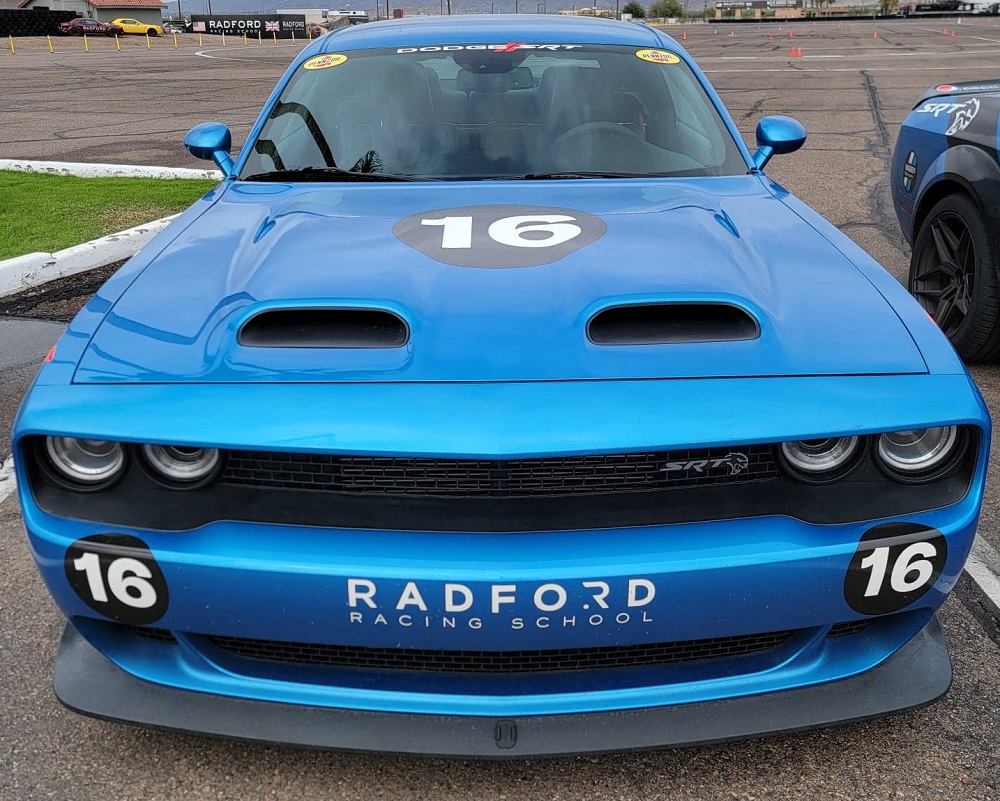
My first of track-type time in the Radford #16 Dodge Challenger SRT® Hellcat Redeye was also on the flat tarmac, with a small oval of cones giving us a chance to practice what we learned about braking zones along with information about the apex of a turn and the track-out point beyond the turn. When coupled with the braking zone practice, we had been instructed on how to slow down as we enter a turn, how to keep the car balanced in the turn and how to accelerate away from a turn. The “handling drill” allowed us to put everything that we had learned to practice with lower speeds than we would experience a short time later on the Maricopa oval.
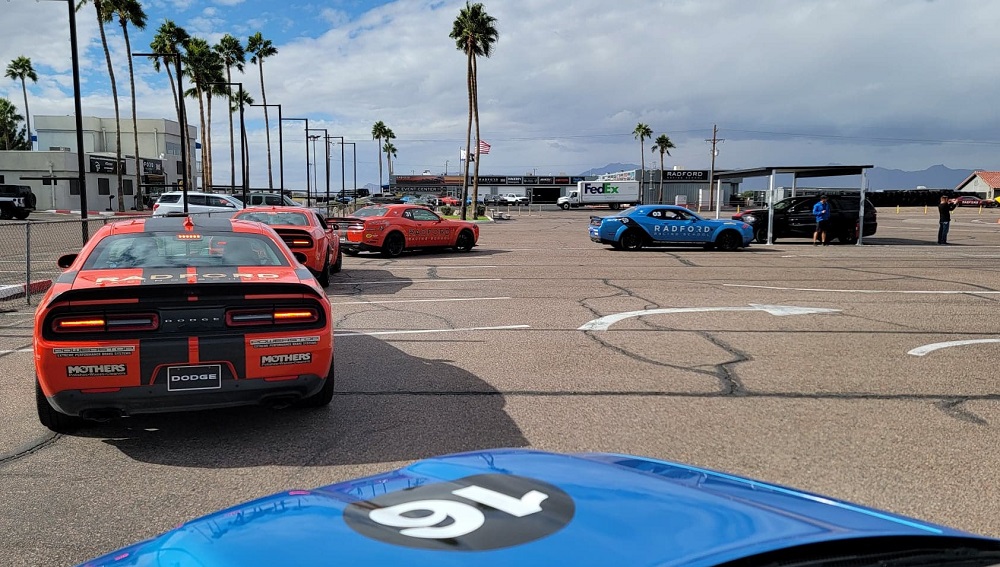
This small oval track allowed us to practice entering and exiting two different shapes of turns, one which allowed us to work on our trail braking with a late apex. We were on this small oval in groups of four, allowing us to experience traffic while working on our turning techniques. It should be noted that you are not permitted to pass in any of the HPD class exercises, regardless of the track. On the handling oval, if you want separation from the car in front of you, you pull into the pit lane area and head back out when the other cars have cleared.
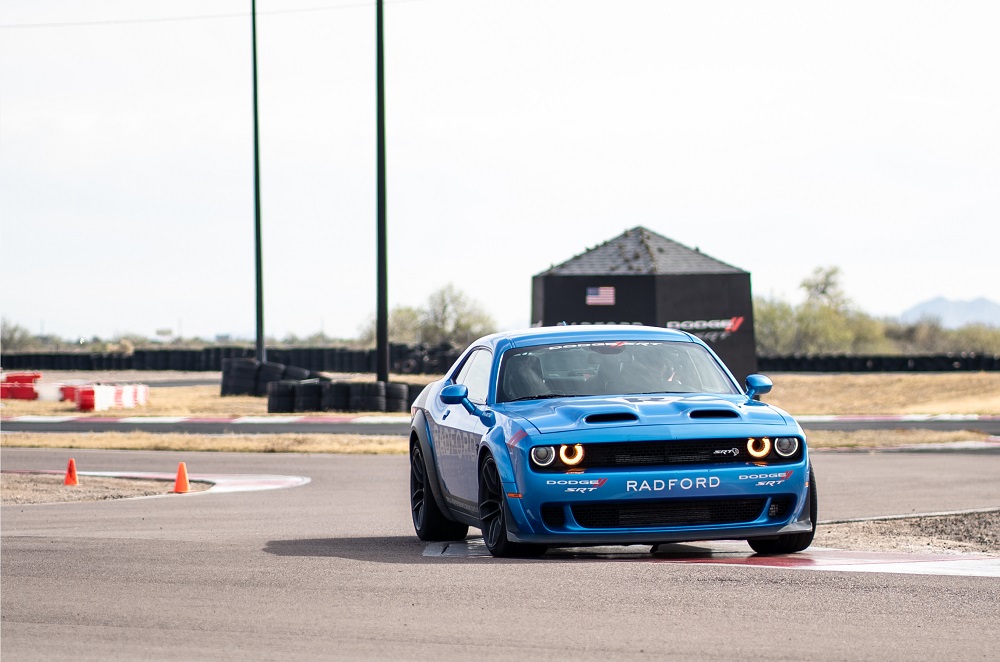
This tight track allowed us to practice braking, turning into the turn, getting through the turn and accelerating out of the turn over and over again in a short period of time. We were only reaching speeds in the range of 50 mph, but on the tight course with three other cars, a great deal of thought goes into safely rocketing around the small oval in an SRT Hellcat Challenger Redeye. After a short session, my group came into the pit lane and the other group went out, allowing one of the instructors to stand with us on the edge of the track and explain to us what we had done right and wrong, while also pointing out what the other students were doing wrong and how to correct those issues. Also, the other instructor with my group was moving from car to car, providing in-car assistance for a handful of laps for each student in the class. He would watch you drive from pit lane, then jump in and provide input, then watch from pit lane again. When you came in from your session, he would provide more information to use on your next session. That went on for about an hour and it was tremendously helpful, as everyone in the class improved dramatically during that track session.
The next step in my second day was time on the Maricopa Oval, where we practiced what we learned on the tarmac oval out on the higher speed track, complete with banked turns, longer straightaways and tires lining the outside wall. On that bigger track, our group of four cars was able to spread out more, allowing us all to reach higher speeds. This really felt like oval track racing, even though we weren’t allowed to pass. The 15-minute sessions allowed me to hit the same two turns over and over, making fine adjustments to how I apply the brakes, how I turn in and where I accelerate to come out of the turn. With each lap, I could feel the car getting around the track a bit more smoothly, often closing the gap to the cars ahead of me. Once again, one instructor watched from the exit to pit row while the other moved from car to car, providing line, braking and steering input with each student. The Maricopa Oval is also big enough that I was able to begin upshifting and downshifting along with letting the SRT Hellcat Redeye really stretch its legs.
Autocross Competition
After an hour on the Maricopa Oval, we headed back to the flat tarmac area for some autocross fun, which is the only timed competition within the Radford Racing School HPD program. Autocross is racing through a series of tight turns made out of cones, which tests the driver’s ability to handle a big car with monster power in a very tight space. Thanks to the Brembo brakes and the Bilstein adaptive dampers, the Challenger SRT Hellcat and Redeye models handle remarkably well in tight quarters, even with the all-season factory tires found on all of the student vehicles. We were told that getting through the course in 25 seconds is a pretty good time while stronger students run in the 24-second range and the best students get into the 23- and high-22-second range.
On my first run, I laid down a solid 25.12 and followed that up with a 25.10. On my third run, I got more aggressive and ran a 24.53 and turning it up a bit more on my fourth run led to a 24.13. On my fifth run, I got a bit too greedy with the throttle and roasted the tires coming out of one of the tight turns, leading to my slowest pass of the day, but on my final run, I pulled it together and laid down a 23.78. That was good enough for second overall and quickest among Redeyes while a student in an SRT Hellcat with a manual transmission ran a 23.39 to win the competition. The autocross was a ton of fun and I’m excited to have done so well.
The Grand Finale
Finally, Radford saves the best for last, with a lengthy session of lead-and-follow on the big road course. My group of eight was split into two groups, with my group being made up of the quickest drivers in the autocross competition and we went out onto the track first. While lead-and-follow might sound unimpressive to some people who have done “experience” driving events from other automakers, the goal with most of those programs is for the instructor or lead driver to limit the speed of the drivers behind him. On the contrary, the instructors from Radford work on going faster and faster each lap, so long as the drivers behind them keep up. That leads to some exciting nose-to-tail racing around the large road course, with speeds reaching well into the triple digits with the Dodge Challenger SRT Hellcats and Redeyes.
During this portion of the HPE program, I got to put everything that I had learned to use along with a few of my classmates. As we roared around the track, there would be times when one of the students toward the front of the group would make a mistake, causing the rest of us to bunch up behind him and there were times when I made a mistake and dropped back. That allowed me to work to turn quicker laps to catch back up to the rest of the field, progressively getting around the track more easily with each lap.
Our day ended back in the classroom with a graduation ceremony, which included a diploma, a Challenger coin with the Hellcat on the front and a military tribute on the back and pair of Radford HPD Graduate stickers, one of which is proudly displayed on the back of my helmet. I had a great time, I got to drive with some great classmates under the instruction of world-class teachers and I came away with invaluable improvements to my driving ability.
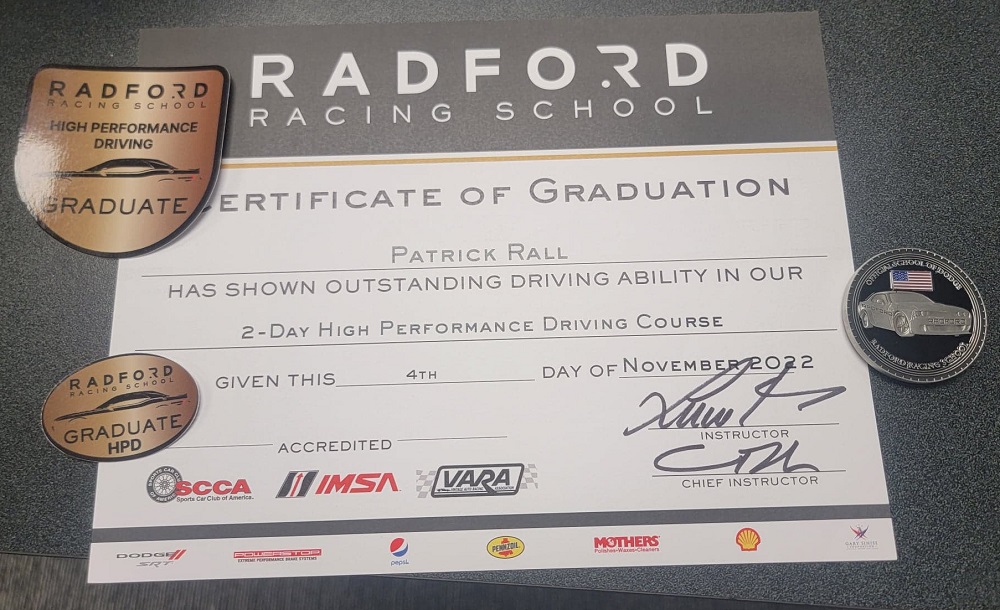
Three-Day HPD and Advanced Performance Driving
The Radford Racing School High Performance Driving program is also offered in a three-day version, and as you might have guessed, the longer program includes loads more driving time. There is really no other class time, so the extra eight-hour session is almost entirely focused on making laps on the big road course.
For those who opt for the three-day program, much of that third day is spent in a Dodge Challenger SRT Hellcat making laps on your own with other students, but there is no instructor leading the pack. During these sessions, the students essentially control the pace, but there is still no passing allowed, so if you are running up on slower cars, you have to pit and wait for the field to get away, at which point you can head back out onto the track without any obstruction until you catch back up. This third day is comprised of short track sessions followed by sessions with the instructors where you talk about what you could be doing better.
Finally, graduates of the basic Radford High Performance Driving program are eligible for the company’s Advanced Road Racing Program. This three- or four-day program is custom tailored to each student and focuses entirely on track time and road racing, with roughly five hours of high-speed track time every day.
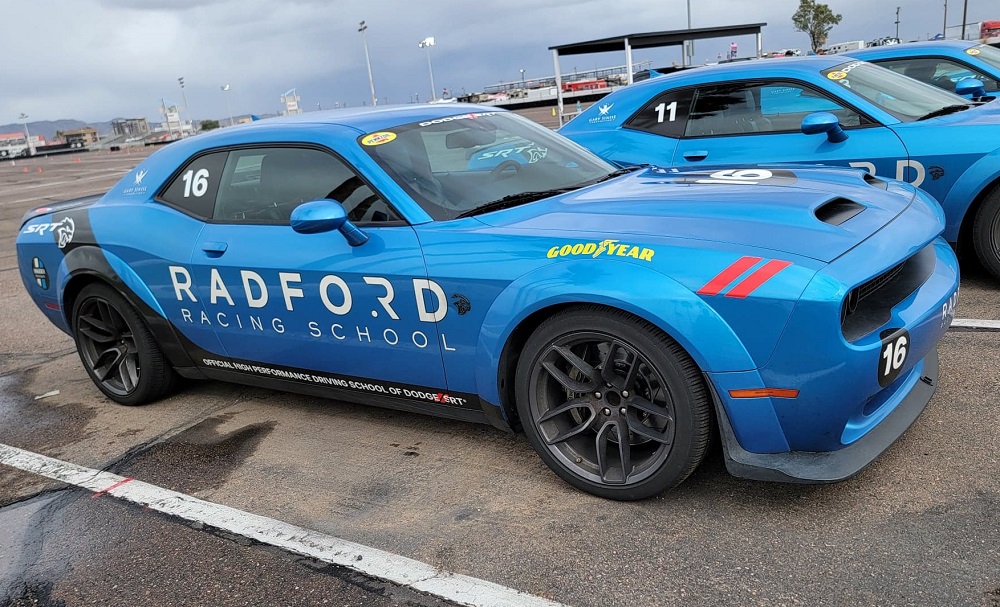
“Radford is an absolute must-do for all drivers. I attended the 3-day performance driving school and cannot express how much I learned about the car, driving, safety and racing. There is a tremendous amount of seat time with and without instructors,” said a new SRT owner who previously took the class. “In fact, a few ‘hot laps’ with Steven will never be forgotten. If you love cars, love horsepower, love racing and just love to be behind the wheel of a 700+ hp beast, you will love Radford Racing School. Sign up if you can, you won’t regret it. Most importantly, send your kids who are just learning to drive as the information learned might one day save their lives. Thank you to the entire team at Radford for making the last few days so fun!”

0 Comments